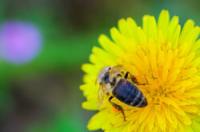Establish butterfly species in the garden
The diversity of plants in the garden attracts many species of butterflies. If you pay attention to special plants, you don't have to wait long for the moths.
Would you like to attract many species of butterflies to your garden? Create a varied retreat with local wild trees, flowers, herbs and wild plants and the colorful folds will appear. Since there are fewer and fewer natural meadows and groves, natural gardens are in demand as habitats for butterflies.
This is how different types of butterflies feel good in the garden
The development cycle of butterflies comprises three stages: the caterpillar stage, life as a pupa and finally the life stage as a fully-grown butterfly, also known as the imago.
Caterpillars and butterflies need certain plants for food. There are often different plants, depending on the type of butterfly. The doll needs a quiet place where it can develop undisturbed.
As a rough guideline, you can keep in mind that native wild trees and plants are better for caterpillars and butterflies than exotic plants from foreign countries. Unstuffed flowers and blooming
Herbs offer the necessary variety for a butterfly garden.The different types of butterflies like it colorful. Colorful plantings are attractive, more English race, surrounded by an evergreen thuja hedge or bamboo stalks, but not.
When the butterflies flutter across the land, it's summer. With the right plants ...
The trade now offers seed mixtures for wild meadows. Convert part of your lawn into one. Native meadow flowers are a paradise for peacock butterflies, brimstone butterflies and more.
Do not use any chemicals in the garden, either in the Pest Control as well as when fertilizing. Butterflies are very sensitive. Even small amounts are toxic.
If you don't know what is crawling or flying, you can find help in the following forums:
www.insektenforum.com/forum/index.php
www.lepiforum.de
Forage plants for the butterfly caterpillars - an overview
The following list shows that not only "weeds" are suitable, but also ornamental and useful plants. The nettle is of outstanding importance. 50 different butterfly species are said to lay their eggs on this plant alone.
The overview lists the plants and the types of butterflies whose caterpillars feed on them.
| plant | attracted butterflies |
| Nettle |
Peacock butterfly Little fox admiral Land map Painted Lady |
| Thistles |
admiral Painted Lady Fox butterfly |
| Pastures |
Mourning gown Common Schiller Butterfly Big fox |
| violet |
Imperial coat Mother-of-pearl butterfly |
| broom |
Blues Blackberry moth |
| hop | Peacock butterfly |
| Buckthorn | Brimstone butterfly |
| phlox | Aurora butterfly |
| Sedum plant | Apollo |
| honeysuckle | Little kingfisher |
|
Blueberry sloe |
numerous nightlife such as owl butterflies |
|
Raspberries Blackberries |
Imperial coat Blackberry moth Mother-of-pearl butterfly |
|
Umbelliferous fennel dill Wild carrot |
dovetail |
|
clover Laburnum Vetch Flat pea |
Blues Postillon Mustard whites |
|
Ball of grass Pipe grass Repgrass grass Trespe Schmiele |
Ophthalmic butterflies Thick-headed butterflies |
This list is only a part of the great variety of possibilities. Other plants for butterfly species are: leeks, quaking aspen, hawthorn, plantain, adder's head, hawkweed and many others.
Attract adult butterflies
When the adult butterfly hatches from the pupa, it needs nectar-rich flowers. These do not have to match the forage plant of the caterpillar.
Colorful flowers attract butterflies: butterflies particularly love red or purple flowers, while moths love white or delicate tones. Of course, yellow or blue flowers are also flown to, the main thing is that the nectar content is correct.
You may be familiar with Buddleja as a butterfly bush. You can also plant thistles, coneflowers, splendid slits, beard flowers, phlox, lavender, Blue pillows and autumn asters.
Avoid exotic species and look back on many old cottage garden plants. Proven to be uncomplicated for centuries, these mostly turn out to be butterfly or bee-friendly.
in the Herb garden Butterflies will also find food if you let some plants bloom. Dill, sage, lemon balm and thyme work very well.
If you have managed to make butterflies feel good in your garden, make sure that they stay. Don't cut them all in the fall Perennials and Grasses return. Leaves should also remain. These habitats are important for pupae and adult moths to hibernate. Brimstone butterfly and peacock butterfly are species of butterflies that hibernate as imago.


